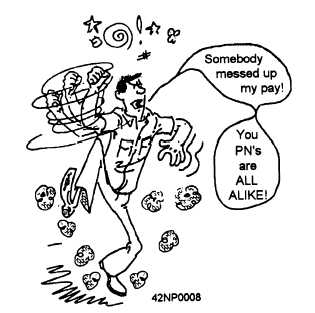| |
Figure 1-7.—Beware of your attitude—the customer knows what you are feeling.
State of Mind
Regardless of the nature or seriousness of the
customer’s problem, certain negative factors may
serve to complicate it. The customer may exhibit the
following behaviors:
. Be angry, worried, or frustrated
. Lack confidence in your abilities
. Be unwilling to accept anything less than the
desired solution to a problem
However, if you can recognize these factors and
make appropriate allowances for them, you may avoid
further complicating the customer’s problem.
The customer who is emotionally upset (angry,
worried, or frustrated) may have difficulty in stating a
problem accurately or completely. Significant
information may be omitted; opinions may be
confused with facts; or there may be a feeling that the
information you are requesting is too personal.
Usually, it will help if you can first determine the cause
and target of the customer’s emotional upset. What
caused the anger? To whom is it directed? You may be
able to sort out this information by letting the customer
“unload,” as depicted in figure 1-8. Leading questions
should fill any blank spots.
The old adage, “The customer is always right,” is
not true in all situations. Personal abuse is not a “right”
of the customer. But, the customer who is allowed to
“blow off steam” (within reason) may then become
apologetic and ready to accept your help.
When you are faced with an upset customer,
remember that your purpose is to serve that customer’s
needs. Any other response on your part that may cause
the customer to become more irritated is not
appropriate. Try to calm the customer and maintain
your self-composure.
If you start shouting back
Figure 1-8.—Dealing with an angry customer.
1-13
|

